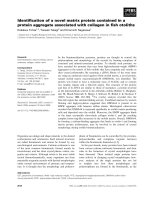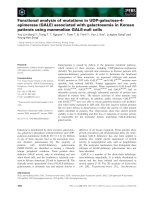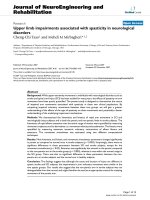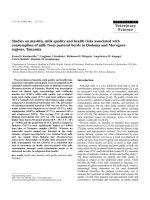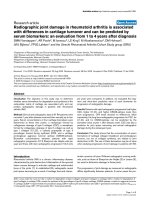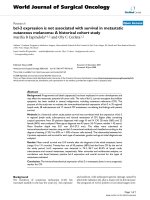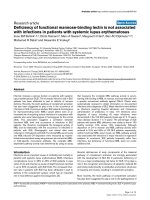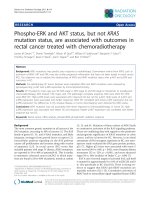Are we missing opportunities understanding health behaviours associated with overweight in pregnancy
Bạn đang xem bản rút gọn của tài liệu. Xem và tải ngay bản đầy đủ của tài liệu tại đây (7.33 MB, 381 trang )
ARE WE MISSING OPPORTUNITIES?
UNDERSTANDING HEALTH BEHAVIOURS
ASSOCIATED WITH OVERWEIGHT IN
PREGNANCY
Susan Jane de Jersey
MPH, BHlthSci (Nut&Diet) (Hons), BAppSci (HMS) (Hons)
This thesis is submitted for the degree of Doctor of Philosophy
in the School of Nutrition and Exercise Science,
Queensland University of Technology
April, 2013
Keywords
Pregnancy, weight gain, overweight, nutrition, physical activity, knowledge
attitudes practice, behaviour change, maternal health, obesity prevention,
PRECEDE-PROCEED model
Are we missing opportunities? Understanding health behaviours associated with overweight in
pregnancy
i
Abstract
While maternal obesity, excess pregnancy weight gain and lifestyle
behaviours are associated with future overweight for both mothers and
babies, there is limited research on how best to intervene. An evidence base
that identifies behavioural influences is crucial to the development of effective
interventions. This thesis aims to gain an understanding of maternal
behavioural outcomes of healthy eating, physical activity and gestational
weight gain (GWG), the psychosocial influences on these and to examine
differences according to pre-pregnancy weight status.
The New Beginnings Healthy Mothers and Babies Study was a prospective
observational study using the PRECEDE-PROCEED model of health
promotion planning as a framework. A consecutive sample of 715 women
was recruited. Height and weight were measured and women completed
questionnaires at approximately 16 and 36 weeks gestation. This thesis
presents three chapters of original research across four study domains.
While healthy eating was widely regarded as important during pregnancy and
had become more so, there was more variability in attitudes towards physical
activity. Ninety-two percent of participants achieved the maximum knowledge
score relating to the influence of nutrition on pregnancy. However, 8% and
36% respectively knew how many serves of fruit and vegetables should be
consumed daily. Six percent of participants met the recommendations for fruit
consumption, 4% achieved the recommended vegetable intake and 44%
achieved sufficient physical activity. There were few differences between
healthy and overweight women for measures of physical activity and healthy
eating.
Many predisposing, reinforcing and enabling factors with a positive influence
on health behaviours were lower in women commencing pregnancy
overweight and those factors with a negative influence on health behaviours
were higher when compared to healthy weight women. Some of these
antecedents to health behaviours that were different according to prepregnancy weight status were associated with diet quality and physical
activity. While self efficacy was consistently associated with diet quality and
Are we missing opportunities? Understanding health behaviours associated with overweight in
pregnancy
ii
physical activity for both weight groups, other associations between specific
predisposing, reinforcing and enabling factors differed with behaviour and
weight status group. These results highlight the complexity of supporting
behaviour change in a one-size-fits-all approach.
Sixty-four percent of participants gained weight outside of recommendations.
Compared to healthy weight women, those women who were already
overweight at the beginning of pregnancy were more likely to gain too much
weight (30% vs 56%, p<0.001). Only 35% of participants reported their
correct recommended weight gain. Excess GWG was associated with few
predisposing factors, however, these were not consistent between prepregnancy weight status groups.
Less than 50% of women reported sometimes/usually/always receiving
advice from health professionals relating to healthy eating, physical activity or
GWG. These results indicate that there are opportunities to improve the
advice and support provided by health care professionals in the antenatal
period.
Evidence from this PhD research suggests that there is a need for effective
prevention and management of excess weight in pregnancy. Effective
management of this problem is likely to require a multidisciplinary approach
with multi-level strategies. Importantly, the strategies may need to be tailored
according to pre-pregnancy weight status.
Collectively, the evidence derived from this thesis suggests that opportunities
to support healthy lifestyles and prevent future overweight are being missed
during pregnancy..
Are we missing opportunities? Understanding health behaviours associated with overweight in
pregnancy
iii
Table of Contents
Keywords ................................................................................................................................... i
Abstract......................................................................................................................................ii
Table of Contents .....................................................................................................................iv
List of Publications................................................................................................................... vii
List of Figures ...........................................................................................................................ix
List of Tables ............................................................................................................................ix
List of Abbreviations ................................................................................................................ xii
Statement of Original Authorship ........................................................................................... xiv
Acknowledgements .................................................................................................................xv
CHAPTER 1: INTRODUCTION ............................................................................................. 17
1.1 Background .................................................................................................................. 17
1.2 Objectives..................................................................................................................... 20
1.2.1 Nutrition and Physical Activity Domain .............................................................. 20
1.2.2 Maternal Psychosocial Domain.......................................................................... 21
1.2.3 Maternal Weight Domain ................................................................................... 21
1.2.4 Service Delivery Domain.................................................................................... 21
1.3 Significance .................................................................................................................. 21
1.4 Context ......................................................................................................................... 22
1.5 Overview of the Thesis ................................................................................................. 23
CHAPTER 2: LITERATURE REVIEW .................................................................................. 27
2.1 The Problem of Maternal Overweight .......................................................................... 27
2.1.1 Definition and Prevalence .................................................................................. 27
2.1.2 Consequences of Maternal Overweight for Mothers and Babies ...................... 29
2.1.3 Costs Associated with Overweight in Pregnancy .............................................. 32
2.2 Modifiable Risk Factors for Development of Overweight in Mothers and Offspring .... 32
2.2.1 Consideration of Non-modifiable Influences Contributing to Overweight .......... 33
2.2.2 Nutrition .............................................................................................................. 34
2.2.3 Physical Activity ................................................................................................. 38
2.2.4 Gestational Weight Gain .................................................................................... 41
2.3 Changing Health Behaviours ....................................................................................... 62
2.3.1 Health Behaviour and Education ....................................................................... 62
2.3.2 Health Behaviour Theories ................................................................................ 62
2.3.3 Using Theory to Design Intervention ................................................................. 69
2.3.4 Psychosocial Determinants of Health Behaviours in Pregnancy ....................... 72
2.3.5 Pregnancy as a Time for Change ...................................................................... 83
2.4 Evidence to Guide Intervention .................................................................................... 84
2.4.1 Introduction ........................................................................................................ 84
2.4.2 Reviewing the Reviews ...................................................................................... 85
2.4.3 Examining the Evidence .................................................................................... 93
2.4.4 Summary of Evidence to Guide Interventions ................................................. 109
2.5 Conclusion: Literature Review ................................................................................... 109
CHAPTER 3: METHODOLOGY .......................................................................................... 115
3.1 Methodology ............................................................................................................... 115
3.1.1 Methodology..................................................................................................... 115
3.1.2 Participants ...................................................................................................... 115
3.1.3 Sample Size ..................................................................................................... 116
3.2 Procedure and Timeline ............................................................................................. 116
3.2.1 Recruitment ...................................................................................................... 116
3.2.2 Data Collection ................................................................................................. 119
3.2.3 Overall Project Theoretical Framework ........................................................... 122
Are we missing opportunities? Understanding health behaviours associated with overweight in
pregnancy
iv
3.3
3.4
3.5
3.6
3.7
Instruments ................................................................................................................ 125
3.3.1 Instrument Development ................................................................................. 125
3.3.2 Time 1 .............................................................................................................. 125
3.3.3 Time 2 .............................................................................................................. 126
Measures ................................................................................................................... 127
Participant Retention Strategy ................................................................................... 136
Data Management and Analysis ................................................................................ 136
3.6.1 Data Management ........................................................................................... 136
3.6.2 Data Quality ..................................................................................................... 136
3.6.3 Analysis ........................................................................................................... 137
3.6.4 Statistical Methods .......................................................................................... 138
Ethics and Health and Safety .................................................................................... 140
3.7.1 Ethics Considerations ...................................................................................... 140
3.7.2 Health and Safety ............................................................................................ 140
CHAPTER 4: RECRUITMENT, PARTICIPATION AND CHARACTERISTICS ..................141
4.1 Chapter Overview ...................................................................................................... 141
4.2 Recruitment and Participant Flow .............................................................................. 141
4.2.1 Outcomes of Recruitment ................................................................................ 141
4.2.2 Flow of Study Participants ............................................................................... 143
4.3 Baseline Participant Characteristics .......................................................................... 143
4.3.1 Demographic Characteristics .......................................................................... 143
4.3.2 Anthropometric Characteristics ....................................................................... 145
4.4 Discussion of Participant Recruitment and Baseline Characteristics ........................ 147
CHAPTER 5: MATERNAL NUTRITION AND PHYSICAL ACTIVITY DOMAIN .................149
5.1 Overview .................................................................................................................... 149
5.2 Results ....................................................................................................................... 149
5.2.1 What Women Think: Importance of Behaviours .............................................. 149
5.2.2 What Women Know ......................................................................................... 150
5.2.3 What Women are Doing .................................................................................. 151
5.2.4 What Support Women are Receiving .............................................................. 155
5.2.5 What Support Women Want ............................................................................ 156
5.3 Discussion.................................................................................................................. 157
5.3.1 What Women Think: Importance of Behaviours .............................................. 158
5.3.2 What Women Know ......................................................................................... 160
5.3.3 What Women are Doing: Dietary Behaviour and Physical Activity ................. 160
5.3.4 What Support Women are Receiving and Want.............................................. 163
5.3.5 Summary ......................................................................................................... 164
CHAPTER 6: MATERNAL PSYCHOSOCIAL DOMAIN .....................................................166
6.1 Overview .................................................................................................................... 166
6.1.1 Overview of Methods ....................................................................................... 166
6.2 Results ....................................................................................................................... 167
6.2.1 Internal Consistency of Scales ........................................................................ 167
6.2.2 Psychosocial Factors and Pre-pregnancy Weight Status ............................... 168
6.2.3 Psychosocial Factors Contributing to Health Behaviours ............................... 174
6.3 Discussion.................................................................................................................. 181
6.3.1 Differences Between Healthy and Overweight Women .................................. 181
6.3.2 Reinforcing and Enabling Factors ................................................................... 188
6.3.3 Psychosocial Factors Contributing to Health Behaviours ............................... 190
6.3.4 Summary ......................................................................................................... 194
CHAPTER 7: MATERNAL WEIGHT DOMAIN ....................................................................196
7.1 Overview .................................................................................................................... 196
7.1.1 Overview of Methods ....................................................................................... 196
7.2 Results ....................................................................................................................... 197
7.2.1 Gestational Weight Gain.................................................................................. 197
Are we missing opportunities? Understanding health behaviours associated with overweight in
pregnancy
v
7.3
7.2.2 Weight Gain Knowledge .................................................................................. 199
7.2.3 Health Professional Support ............................................................................ 200
7.2.4 Psychosocial Factors Contributing to Energy Balance .................................... 200
7.2.5 Predicting Gestational Weight Gain ................................................................. 203
Discussion .................................................................................................................. 208
7.3.1 Prevalence of Excess Gestational Weight Gain .............................................. 208
7.3.2 Weight Gain Knowledge .................................................................................. 209
7.3.3 Health Professional Support ............................................................................ 210
7.3.4 Predicting Gestational Weight Gain ................................................................. 213
7.3.5 Summary .......................................................................................................... 218
CHAPTER 8: OVERALL DISCUSSION AND IMPLICATIONS .......................................... 221
8.1 Overview .................................................................................................................... 221
8.2 Contribution to Knowledge ......................................................................................... 221
8.2.1 Nutrition and Physical Activity Domain (Chapter 5) ......................................... 221
8.2.2 Maternal Psychosocial Domain (Chapter 6) .................................................... 223
8.2.3 Maternal Weight Domain (Chapter 7) .............................................................. 225
8.2.4 Service Delivery Domain (Chapter 5 and Chapter 7) ...................................... 226
8.2.5 Summary .......................................................................................................... 227
8.3 Strengths and Limitations ........................................................................................... 228
8.3.1 Study Design and Sampling............................................................................. 228
8.3.2 Measurement ................................................................................................... 229
8.3.3 Procedure and Analysis ................................................................................... 231
8.4 Implications for Practice ............................................................................................. 233
8.4.1 Recognition of a Need for Effective Management ........................................... 233
8.4.2 Recognising Pregnancy as a Unique Opportunity for Change ........................ 234
8.4.3 Effective Management Requires Multidisciplinary and Multi-level
Intervention ...................................................................................................... 235
8.4.4 Consideration of Dietary and Physical Activity Changes as a Primary
Outcome........................................................................................................... 244
8.5 Future Research Directions ....................................................................................... 245
8.6 Conclusion.................................................................................................................. 246
References ........................................................................................................................... 249
Appendices ........................................................................................................................... 287
A.
Peer Reviewed Publication Arising from PhD .................................................. 287
B.
Peer Review Publications Under Review ........................................................ 288
C.
International Media Interest ............................................................................. 322
D.
Mail Out Recruitment Information Sheet.......................................................... 328
E.
Participant Information Sheet........................................................................... 329
F.
Participant Consent Form ................................................................................ 331
G.
Time 1 Questionnaire Version 1 for Expert Panel Review .............................. 332
H.
Expert Panel and Pilot Feedback .................................................................... 348
I.
Final Time 1 Questionnaire .............................................................................. 352
J.
Final Time 2 Questionnaire .............................................................................. 361
K.
Correlations Between Predisposing, Reinforcing and Enabling Factors for
Healthy Eating, Physical Activity and Weight Gain .......................................... 369
L.
Full Models for Prediction of Excess GWG...................................................... 372
Are we missing opportunities? Understanding health behaviours associated with overweight in
pregnancy
vi
List of Publications
Peer reviewed publications arising from this thesis:
de Jersey SJ, Nicholson JM, Callaway LK, Daniels L. Missed opportunities:
Pregnancy weight gain in Australian women. 2012 Australian and New Zealand
Journal of Obstetrics and Gynaecology DOI: 10.1111/ajo.12013 (Appendix A)
de Jersey SJ, Nicholson JM, Callaway LK, Daniels L. More and Less: the perceived
importance of eating well and physical activity in pregnancy. 2012 (under review
Maternal and Child Health) (Appendix B)
de Jersey SJ, Nicholson JM, Callaway LK, Daniels L. Nutrition and physical activity
knowledge, behaviours, and advice at 16 weeks gestation of pregnancy: Are we
doing enough? 2012 (for submission to BMC Pregnancy and Childbirth (Appendix B)
Peer reviewed publications related to this thesis:
Rowlands IJ, Callaway LK, Graves N, de Jersey SJ and McIntyre HD. Obesity in
pregnancy: Outcomes and economics. Seminars in Fetal & Neonatal Medicine: 15,
(2), 94-99, 2010.
de Jersey SJ, Ross LJ, Himstedt K, McIntyre HD, Callaway LK. Nutritional intake
and weight gain in obese pregnant women—some clues for intervention. Nutrition
and Dietetics 68, 53-59, 2011
Ross LJ, Barrett HG, de Jersey SJ, Callaway LK. Measuring features of the
metabolic syndrome in early pregnancy is a useful activity and predicts women who
will develop GDM. 2012 (under review) Australian and New Zealand Journal of
Obstetrics and Gynaecology
Callaway LK, Colditz PB, Byrne NM, Lingwood BE, Rowlands IJ, Foxcroft K,
McIntyre, HD, BAMBINO Study Group. Prevention of gestational diabetes:
Feasibility issues for an exercise intervention in obese pregnant women. Diabetes
Care: 33 (7), 1457-9, 2010
Byrne NM, Groves AM, McIntyre HD, Callaway LK, BAMBINO Group. Changes in
resting and walking energy expenditure and walking speed during pregnancy in
obese women American Journal of Clinical Nutrition published 27 July 2011,
10.3945/ajcn.110.009399
Conference presentations related to this thesis:
de Jersey SJ, Oftedal S, Callaway LK, Nicholson JM, Daniels L. Predisposing
factors for health eating differ according to pre-pregnancy weight status and predict
eating behaviours. Dietitians Association of Australia National Conference, Adelaide,
Australia, May 2011 Nutrition and Dietetics 68 (s1), 2011
de Jersey SJ, Callaway LK, Nicholson JM, Daniels L. A critical review of lifestyle
interventions in overweight and obese pregnant women: Are dietitians the key?.
Dietitians Association of Australia National Conference, Adelaide, Australia, May
2011. Nutrition and Dietetics 68 (s1), 2011
Are we missing opportunities? Understanding health behaviours associated with overweight in
pregnancy
vii
Oftedal S, de Jersey SJ, Nicholson JM, Daniels L. Health concerns are barriers to
healthy eating in early pregnancy and differ between healthy and overweight
women. Dietitians Association of Australia National Conference, Adelaide, Australia,
May 2011. Nutrition and Dietetics 68 (s1), 2011
de Jersey SJ, Oftedal S, Callaway LK, Nicholson JM, Daniels L. Predictors of
health behaviours differ in healthy weight and overweight women. International
Society of Behavioural Nutrition and Physical Activity, Melbourne, Australia 2011
de Jersey SJ, Oftedal S, Callaway LK, Nicholson JM, Daniels L. Psychosocial and
demographic factors associated with healthy eating intentions in pregnancy for
healthy weight and overweight women. International Society of Behavioural Nutrition
and Physical Activity, Melbourne, Australia 2011
de Jersey SJ, Callaway LK, Nicholson JM, Daniels L. Risky Business: Weight
related knowledge and risk perception is different for healthy and overweight
pregnant women. European Congress of Obesity, Lyon, France. Obesity Facts 5
(Suppl 1) May 2012 p194
de Jersey SJ, Callaway LK, Nicholson JM, Daniels L. More and less: Importance of
eating well and regular physical activity in pregnancy. International Society of
Behavioural Nutrition and Physical Activity, Austin, USA, 2012
de Jersey SJ, Callaway LK, Nicholson JM, Daniels L. Perception of change in
nutrition and physical activity appears different by weight status in pregnant women.
International Society of Behavioural Nutrition and Physical Activity, Austin, USA,
2012
de Jersey SJ, Callaway LK, Nicholson JM, Daniels L. Too much, not enough: The
problem of gestational weight gain and opportunities for dietetic leadership.
International Congress of Dietetics, Sydney, Australia, Nutrition and Dietetics 69
(Suppl 1) Sept 2012
Menzies L, de Jersey SJ, Callaway LK, Nicholson JM, Daniels L. Does prepregnancy BMI influence the perception of barriers to healthy eating early in
pregnancy? International Congress of Dietetics, Sydney, Australia, Nutrition and
Dietetics 69 (Suppl 1) Sept 2012
Conference presentation as an invited speaker
Limiting Complications - Nutritional issues in pregnancy post weight loss surgery.
Society of Obstetric Medicine Australia New Zealand (SOMANZ)/Australasian
Diabetes in Pregnancy Society (ADIPS) Combined Annual Scientific Meeting,
Brisbane, November 2011
Media interest
QUT Media and Communications prepared a media release on this project to
coincide with publication of the manuscript in Australian and New Zealand Journal of
Obstetrics and Gynaecology. This research was disseminated around the world
through news and consumer websites, outlined in Appendix C.
Are we missing opportunities? Understanding health behaviours associated with overweight in
pregnancy
viii
List of Figures
Figure 1.1 Diagram of relationships between risk factors in pregnancy and future
overweight in mothers and offspring
Figure 2.1 Diagram of SCT constructs and interactions
146
Figure 2.2 Generic diagram of the elaborated HAPA model
18
64
156
68
Figure 2.3 Model of a teachable moment for weight control in pregnancy
83
Figure 3.1 Recruitment flow chart
117
Figure 3.2 The PRECEDE-PROCEED model277
123
Figure 4.1 Progression of participants through the New Beginnings study time points
from recruitment through to 36 week follow up
142
Figure 5.1 Reported change in the importance of (a) eating well and (b) physical
activity since becoming pregnant for healthy* (n=382) and overweight**
(n=193) women
150
Figure 5.2 Reported change in amount of food since commencing pregnancy for
healthy (n=384) and overweight (n=194) women
152
Figure 5.3 Reported change in amount of physical activity since commencing
pregnancy for healthy (n=382) and overweight (n=193) women
154
List of Tables
Table 2.1
WHO classification of BMI21
27
Table 2.2
Queensland studies reporting overweight prevalence in an obstetric
population
29
Table 2.3
Australian Guide to Healthy Eating core food group serves for nonpregnant, pregnant and lactating women
37
Table 2.4
Components of gestational weight gain for a woman gaining 12.4kg,
delivering a 3.3kg baby92
41
Table 2.5
Summary of weight gain recommendations (in kg) by three different
authors by pre-pregnancy weight status
44
6
Table 2.6
New 2009 IOM weight gain recommendations for pregnancy
46
Table 2.7
Summary of studies examining associations with gestational weight gain
(GWG) and childhood overweight
50
Table 2.8
Calculated OR for childhood overweight from different maternal prepregnancy BMI and GWG combinations from Olson et al (2007)9
58
Table 2.9
Similarities of constructs in five health behaviour theories (adapted from
Noar and Zimmerman 2005158)
70
Table 2.10 Studies examining the relationship between dietary behaviour and
psychosocial factors in pregnant and post-partum women
74
Table 2.11 Studies examining the relationship between psychosocial variables and
physical activity in pregnancy
78
Are we missing opportunities? Understanding health behaviours associated with overweight in
pregnancy
ix
Table 2.12 Summary of the reviews that synthesise the evidence to guide effective
management or prevention of overweight in pregnancy
86
Table 2.13 Primary studies that report weight related outcomes (n=20) of
interventions in women who commence their pregnancy overweight or
that aim to prevent excess weight gain
95
Table 3.1
Sample size calculations for categorical outcome variables
116
Table 3.2
Data collection for each domain with corresponding time points
121
Table 3.3
Description of study measures, source and management for analysis
used in the New Beginnings study
128
Table 4.1
Demographic characteristics of the New Beginnings Healthy Mothers and
Babies Study sample, women delivering at the RBWH and Queensland
public hospitals [percentage (count) or percentage]
144
Characteristics of New Beginnings study sample, and comparison
between healthy and overweight participants’ reported at about 16 weeks
gestation [Mean + s.d. and (range) or percentage (count)]
145
Anthropometric characteristics of women delivering at the RBWH* and
Queensland public hospitals* and the New Beginnings study sample
[Mean + s.d]
146
Body mass index classification for the New Beginnings Healthy Mothers
and Babies Study sample at first visit and pre-pregnancy and women
delivering at the RBWH*, Queensland public hospitals* [percentage
(count) or percentage]
146
New Beginnings study sample and comparison between healthy* and
overweight+ participants for dietary behaviour measures reported at about
16 weeks gestation [Mean + s.d]
153
New Beginnings study sample and comparison between healthy* and
overweight+ participants for physical activity per week reported at about
16 weeks gestation [median (interquartile range)]
155
New Beginnings study sample and comparison between healthy* and
overweight+ participants for sufficient minutes and sessions of physical
activity per week reported at about 16 weeks gestation [percentage
(count)]
155
New Beginnings study sample reporting sometimes/usually/always being
provided with health professional advice relating to healthy eating and
physical early and later in pregnancy [percentage (count)]
156
Internal consistency analysis of psychosocial constructs in New
Beginnings study sample
168
Table 4.2
Table 4.3
Table 4.4
Table 5.1
Table 5.2
Table 5.3
Table 5.4
Table 6.1
Table 6.2
Table 6.3
Table 6.4
a
Comparison of risk perception measures between healthy and
overweightb women reported at about 16 weeks gestation
169
+
Comparison of healthy weight* and overweight women reporting that
each condition was likely‡ to occur during their pregnancy reported at
about 16 weeks gestation of the [percentage (count)]
169
+
Comparison of healthy weight* and overweight women reporting that
pre-pregnancy weight and excess weight gain is likely‡ to cause health
problems reported at about 16 weeks gestation [percentage (count)]
170
a
Table 6.5
Comparison of intentions for health behaviours between healthy and
overweightb women reported at about 16 weeks gestation [Median (IQR)]
171
Table 6.6
Comparison of outcome expectations for health behaviours between
healthya and overweightb women reported at about 16 weeks gestation
[Median (IQR)]
172
Are we missing opportunities? Understanding health behaviours associated with overweight in
pregnancy
x
Table 6.7
Comparison of self efficacy for health behaviours between healthya and
overweightb women reported at about 16 weeks gestation [Mean+ s.d]
172
Table 6.8
Comparison of social support for health behaviours between healthya and
overweightb women reported at about 16 weeks gestation [Mean+ s.d]
173
Table 6.9
a
Comparison of barriers for health behaviours between healthy and
overweightb women reported at about 16 weeks gestation
Table 6.10 Summary of comparison between overweight and healthy weight women
for predisposing, reinforcing and enabling factors for healthy eating,
physical activity and GWG control at about 16 weeks gestation
173
174
#
Table 6.11 Hierarchical linear regression for the Fat and Fibre Behaviour
Questionnaire score reported at about 16 weeks gestation, stratified by
pre-pregnancy weight status of healthya and overweightb
176
#
Table 6.12 Hierarchical, linear regression for minutes of physical activity reported at
about 16 weeks gestation, stratified by pre-pregnancy weight status of
healthya and overweightb
179
Table 6.13 Summary of hierarchical, linear regression for healthy eating and physical
activity, stratified by pre-pregnancy weight status of healthya and
overweightb
180
Table 7.1
Table 7.2
Anthropometric measures and gestational weight gain (GWG) according
to the pre-pregnancy weight status‡ of participants (n=664) [Mean + s.d.
(range) or percentage (count)]
198
Anthropometric measures and gestational weight gain (GWG) for the
study cohort, healthy weight* and overweight+ participants [Mean + s.d.
(range) or percentage (count)]
199
6
Table 7.3
Institute of Medicine (IOM) recommended weight gain ranges for body
mass index (BMI) categories* and participant reported ranges
200
Table 7.4
New Beginnings study women reporting never/rarely being provided with
health professional advice relating to appropriate weight management
early and later in pregnancy [percentage (count)]
200
Hierarchical, logistic regression for perceived amount of food consumed
(‘a lot more’) since the beginning of pregnancy, reported at 16 weeks
gestation for whole New Beginnings sample (n=570)
202
Hierarchical, logistic regression for perceived amount of physical activity
(‘a lot less’) since the beginning of pregnancy, reported at 16 weeks
gestation for whole New Beginnings sample (n=570)
203
Pregnancy, demographic and energy balance variables associated with
not excess vs excess GWGx in healthy and overweight women (Step 1 of
logistic regression modelling)
205
Unadjusted and adjusted odds ratios (OR) for composite psychosocial
constructs explaining not excess gestational weight gain (GWG) and
excess GWGx for healthy and overweight women, using binary logistic
regression
207
Table 7.5
Table 7.6
Table 7.7
Table 7.8
Table 8.1 Summary of suggested behaviour change techniques to support change to
predisposing, reinforcing and enabling factor intervention targets
Are we missing opportunities? Understanding health behaviours associated with overweight in
pregnancy
240
xi
List of Abbreviations
ACOG
American Congress of Obstetricians and Gynaecologists
AGHE
Australian Guide to Healthy Eating
AOR
Adjusted odds ratio
BGL
Blood glucose level
BMI
Body mass index
CDC
Centre for Disease Control
CHO
Carbohydrate
CI
Confidence interval
COAG
Council of Australian Governments
CON
Control
C/S
Caesarean section
DEXA
Dual-energy x-ray absorptiometry
DM
Diabetes mellitus
DOHaD
Developmental Origins of Health and Disease
EN
Energy
FFBQ
Fat and Fibre Behaviour Questionnaire
FFQ
Food Frequency Questionnaire
FTE
Full time equivalent
GDM
Gestational diabetes mellitus
GWG
Gestational weight gain
HAPA
Health Action Process Approach
HBM
Health Belief Model
HDP
Hypertensive disorders of pregnancy
HREC
Human Research Ethics Committee
ht
Height
ID
Identifier
INV
Intervention
IQR
Interquartile range
IOM
Institute of Medicine
kg
Kilogram
LGA
Large for gestational age
LOC
Locus of control
LTPA
Leisure time physical activity
MJ
Mega joule
Are we missing opportunities? Understanding health behaviours associated with overweight in
pregnancy
xii
N/A
Not applicable
NHMRC
National Health and Medical Research Council
NICU
Neonatal Intensive Care Unit
NRV
Nutrient reference value
NSW
New South Wales
OR
Odds ratio
PA
Physical activity
PAL
Physical activity levels
PDC
Perinatal Data Collection
PHR
Pregnancy Health Record
pp
Post-partum
Pro
Protein
Qld
Queensland
QUT
Queensland University of Technology
RBWH
Royal Brisbane and Women’s Hospital
RCT
Randomised controlled trial
RDI
Recommended daily intake
SAQ
Self administered questionnaire
SCT
Social Cognitive Theory
SES
Socioeconomic status
SGA
Small for gestational age
SPAWN
Stockholm Pregnancy and Women’s Nutrition
SPSS
Statistical Package for Social Sciences
T1
Time 1
T2
Time 2
T3
Time 3
T4
Time 4
TPB
Theory of Planned Behaviour
TTM
Transtheoretical Model
UK
United Kingdom
US
United States of America
WC
Waist circumference
WHO
World Health Organisation
WIC
Women, Infants and Children Program
WLOC
Weight locus of control
wt
Weight
Are we missing opportunities? Understanding health behaviours associated with overweight in
pregnancy
xiii
Statement of Original Authorship
The work contained in this thesis has not been previously submitted to meet
requirements for an award at this or any other higher education institution. To
the best of my knowledge and belief, this thesis contains no material
previously published or written by another person except where due
reference is made.
Are we missing opportunities? Understanding health behaviours associated with overweight in
pregnancy
xiv
Acknowledgements
They say ‘it takes a village to raise a child’ and I would have to say that I think the
same can be said for completing a PhD—it is never done alone.
I am grateful to my three supervisors, Professor Lynne Daniels, Professor Jan
Nicholson and Associate Professor Leonie Callaway, for their guidance on this path.
Lynne, you have provided me with personal and professional inspiration; you
demand high standards, which I will carry with me into my future research career.
Jan, I am grateful for your time and attention to detail, and the quality of the
research; this thesis is better because of it. Thank you both for believing in my ability
to complete this challenge. Leonie, you instilled in me, many years ago, a passion
for research, had the insight to support me to develop this passion and assisted in
navigating many organisational corridors. Without the three of you, this task would
not have been completed.
I am grateful for the generous scholarship support provided, initially, by the Royal
Brisbane and Women’s Hospital Research Advisory for (2009-2010, $50K) that
allowed me to commence this research, and then the National Health and Medical
Research Council scholarship (2011-2013, $70K), which allowed me to take a break
from clinical duties in order to complete the project. The scale of this PhD project
was made possible through a grant from the Royal Brisbane and Women’s Hospital
Foundation (2011, $30K) that allowed employment of a research assistant to assist
with tracking participants and collecting data.
Two undergraduate research students and a research assistant assisted to
complete various aspects of the recruitment, data collection and entry. Stina Oftedal
(undergraduate research student) assisted with recruitment and completed some
data entry of the Time 1 questionnaire. Lynda Menzies (undergraduate research
student) and a research assistant (employed part-time) assisted with tracking
participants for 36 weeks follow-up, including postage of Time 2 questionnaires,
weighing in the clinic and some Time 2 data entry. I maintained active participation
in all recruitment, data collection and entry processes, including supervision of the
students and research assistant. I am grateful to the Royal Brisbane and Women’s
Hospital for allowing me to take unpaid study leave to complete this project. Without
the support of the Nutrition and Dietetics team at the RBWH, in particular Lynda
Are we missing opportunities? Understanding health behaviours associated with overweight in
pregnancy
xv
Ross, Maternity Services staff and all of the participants of the New Beginnings
Healthy Mothers and Babies Study, this research would not have been possible.
Thanks also to the Time 1 Expert Panel, Professor Ralf Schwarzer, Doctor Shelley
Wilkinson and Diana Battistuta, as well as the Time 1 Piloters, Nadine Baker, Marita
Christensen, Bianca Clair, Jenny Shirtcliff and Sally Moloney, for invaluable
feedback. Thanks to Chris Page for professional proofreading and editing of this
thesis to ensure consistency.
A special mention must also go to fellow scholars for sharing the adventure—all of
the ‘Nourish’ girls, Adrienne Young, Rebecca Byrne, Jamie Sheard, Helen Vidgen
and Helen Barrett, for therapy coffee. For some, the journey may not quite be over,
but I look forward to celebrating with you on the other side.
I am fortunate to have a group of wonderful and understanding friends, who have
supported me throughout the past three years. They have constantly kept in touch to
offer some diversionary therapy when I seemingly dropped off the radar for a while.
Without sounding too bold, there are too many to mention, however, I must thank
Sarah and Ren for the theatre respite, which was a source of reward throughout.
My extended family in particular my parents in law Peter and Beverley de Jersey
have provided ongoing support throughout this journey. A special mention must also
go to “uncle“ John de Jersey for providing invaluable advice on early drafts of my
scholarship applications and his wife Jan for allowing this to happen in his
retirement.
To my parents John and Nola, I will be forever grateful for the sacrifices you made to
ensure that we received an education. Completion of this degree is testament to
your support. While I am not sure whether my sisters, Fiona and Helen, really
understood what I was doing, but you both knew it wasn’t easy, provided distraction
therapy and a bed on my supervision trips in Melbourne, and I thank you.
My husband, Tim, has been a constant source of comic relief during this challenging
time. Thank you for all the little things you did to make the journey easier; for your
understanding, support and enough patience to make up for both of us. You
ensured that I maintained some balance between work and life, and I look forward to
tipping this further towards life very soon.
Are we missing opportunities? Understanding health behaviours associated with overweight in
pregnancy
xvi
Chapter 1: Introduction
The title of this thesis is ‘Are we missing opportunities? Understanding health
behaviours associated with overweight’. This study has been branded the
New Beginnings Healthy Mothers and Babies Study to signify a time of
positive change and appeal to participants.
1.1 BACKGROUND
The prevalence of obesity is increasing,1 including during pregnancy.2
Recent data indicate that 30-50% of mothers delivering in Queensland
hospitals were pre-obese or obese prior to pregnancy.3 ,4
Prenatal and early life experiences are important determinants of future
chronic disease risk.5 In utero exposure to maternal obesity, diabetes or
excess gestational weight gain (GWG) are key risk factors for the
development of childhood obesity.2 ,6 After birth, the infant is also potentially
exposed to a postnatal family feeding environment that could increase the
risk of childhood obesity. Collectively, genetic, in utero and postnatal
environmental influences may contribute to the development of obesity.
During the reproductive cycle there are several potentially modifiable
pathways to future obesity for mothers and their offspring that will be
addressed in this thesis. The risks associated with offspring from diabetic
mothers will not be elaborated on, as they are beyond the scope of this
thesis. Figure 1.1 represents the potential pathways to future overweight for
mothers and babies during reproduction that have been considered in the
New Beginnings Healthy Mothers and Babies Study.
Chapter 1: Introduction
17
Figure 1.1 Diagram of relationships between risk factors in pregnancy and future
overweight in mothers and offspring
Both high7 ,8 and low8 birthweights have been associated with future
overweight in children. Being born to a mother with an elevated BMI is
associated with a higher birthweight and childhood overweight. Excess
gestational weight gain is also associated with future overweight in offspring,
independent of pre-pregnancy BMI.9 Further excess weight gain contributes
to weight retention for mothers increasing the risk of the development or
exacerbation of overweight.10 Behavioural factors that may contribute to
excess, gestational weight gain are poor maternal nutrition and physical
inactivity.6 Breastfeeding according to the recommended duration and
intensity combined with appropriate nutrition is likely to assist a mother to
return to her pre-pregnancy weight11; failure to achieve this may influence the
development of obesity in both mothers and babies. Evidence suggests that
being breastfed, particularly predominantly or exclusively, is protective
against obesity in childhood and adolescence.12 Therefore, failing to be
breastfed and needing infant formula may lead to childhood overweight.
Overweight women are at an increased risk of failing to initiate and continue
with breastfeeding.13
There is the potential that these pathways may be cumulative. For example,
an obese mother, with a poor dietary intake and sedentary lifestyle who gains
excess weight in pregnancy, does not breastfeed her infant and retains
weight post-partum is likely to be compounding the risks of future overweight
for her child and continuing overweight for herself. Intervening at any point in
this pathway has the potential to reduce the obesity burden for the child,
Chapter 1: Introduction
18
mother and community. While there is increasing recognition of the risk
associated with pre-pregnancy overweight for future chronic disease, those
women and their offspring who commence pregnancy with a healthy BMI
should also be given consideration in the prevention of obesity during
pregnancy.
This research reported in this thesis focussed on a number of risk factors for
future overweight as identified by the shaded boxes in Figure 1.1. Specifically
the relationship between pre-pregnancy BMI (both healthy and elevated) and
excess GWG, maternal nutrition and physical activity have been explored. To
contain the scope of the thesis pregnancy and offspring outcomes have not
been examined.
While maternal obesity, excess gestational weight gain, lifestyle behaviours
and failure to breastfeed have been associated with future overweight for
both mothers and babies, there is little evidence on how to best intervene.14
,15
The issues of healthy lifestyles and primary prevention of chronic disease
are not systematically addressed within antenatal care in the Australian
context. For example, women are not routinely weighed in Queensland
hospitals. Of note is the fact that Australian rates of excess GWG are not
known. This critical prenatal period represents a prime opportunity for health
promotion to reduce the longer term, public health burden of obesity.
To date, a number of intervention studies have targeted women who
commence pregnancy overweight. Published studies vary in quality and have
been predominantly aimed at reducing excess GWG.14 Results have been
inconsistent, with no practical, effective interventions identified. Shortcomings
of programs designed to modify health behaviours in the general population
include a failure to undertake a needs assessment with the target population
to ensure population needs are met and barriers to change are addressed.16
Interventions with overweight pregnant women appear to be no different.
Without a clear description of current behaviours and practices, and an
understanding of the influences on healthy lifestyle behaviours in pregnant
women, it is difficult to design tailored interventions to improve outcomes.
Using appropriate constructs to guide the assessment of target populations is
Chapter 1: Introduction
19
likely to identify approaches that will enhance engagement and adherence to
potential intervention strategies.
The PRECEDE-PROCEED model provides a framework for the assessment,
implementation and evaluation of health promotion programs.16 The
PRECEDE component involves the assessment of predisposing, reinforcing
and enabling constructs in educational diagnosis and evaluation.17 The
PROCEED component relates to the implementation and evaluation of a
program. The proposed research will integrate constructs of dominant health
behaviour change theories to define the constructs of the PRECEDE
component of the model.
The research reported here aimed to address current deficits in Australian
and international literature by undertaking an observational study of pregnant
women to (a) determine the prevalence of excess GWG and (b) identify the
predisposing, reinforcing and enabling factors (psychosocial factors)
associated with healthy lifestyle behaviours during pregnancy. The
theoretical approach underpinning this research is designed to enable the
development of more effective interventions during pregnancy to:
•
support overweight mothers in adopting healthy lifestyles during
pregnancy,
•
gain an appropriate amount weight, and
•
contribute to the prevention of obesity for mothers and their offspring.
Throughout this thesis, predisposing, reinforcing and enabling factors are
collectively referred to as psychosocial factors.
1.2 OBJECTIVES
The primary aims addressed in this research were divided into four domains.
1.2.1 Nutrition and Physical Activity Domain
•
Describe the importance of, and knowledge relating to, healthy eating
and physical activity in pregnancy.
•
Examine the differences in eating and physical activity behaviours
between healthy and overweight women.
Chapter 1: Introduction
20
1.2.2 Maternal Psychosocial Domain
•
Describe the differences between healthy and overweight women on
psychosocial factors associated with healthy eating, physical activity
and gestational weight gain.
•
Examine psychosocial factors associated with healthy eating and
physical activity for healthy and overweight women.
1.2.3 Maternal Weight Domain
•
Describe knowledge relating to gestational weight gain in healthy and
overweight women.
•
Describe the prevalence of excess gestational weight gain (see below)
and examine this according to pre-pregnancy weight status.
•
Identify early pregnancy (<20 weeks gestation) psychosocial factors
that predict excess gestational weight gain at 36 weeks.
Recommendations by the Institute of Medicine for gestational weight gain will
be used to define excess gestational weight gain.6
1.2.4 Service Delivery Domain
•
Describe the advice and support received by pregnant women from
health professionals relating to healthy eating, physical activity and
gestational weight gain.
•
Describe the support services, if any, that pregnant women want to help
them engage in healthy lifestyles and gain appropriate weight.
1.3 SIGNIFICANCE
The New Beginnings Healthy Mothers and Babies Study was a unique study
in an Australian context. The study was designed using a theoretical
framework to guide the future development of an intervention to support
pregnant women to adopt healthy lifestyles, particularly those at high risk of
unhealthy nutrition and physical activity habits. The Council of Australian
Governments (COAG), through its National Early Childhood Development
Strategy18, has identified ‘the best possible start in life’ as a national priority
for improving health outcomes now and for future generations. This study
Chapter 1: Introduction
21
targets one of the identified protective factors (good nutrition and physical
activity) in the antenatal and very early post-partum period. Obesity has been
identified “as a serious and growing national health concern and an
increasing burden on the health care system.”19(p11). Chronic disease with a
focus on maternal and foetal health is a key focus in the current National
Health and Medical Research Council (NHMRC) strategic plan.20 The New
Beginnings study is one of only a few studies to date with a focus on the
antenatal period. It has contributed evidence to guide the development of
interventions to prevent and manage excess weight in pregnancy.
1.4 CONTEXT
The PhD candidate is a Senior Dietitian Nutritionist within the Department of
Nutrition and Dietetics at the Royal Brisbane and Women’s Hospital who
specialises in maternal health. The candidate delivered dietetic care to the
antenatal clinic and maternity ward of the RBWH for six years prior to the
current academic enrolment. The first 14 months of candidature enrolment
were part time, when a component of clinical service delivery in the antenatal
clinic was maintained. The RBWH Research Advisory Committee provided
$50,000 in scholarship funding in 2009 and 2010. The candidate’s clinical
time was backfilled to 0.4 full time equivalent (FTE) for 15 months to allow
project planning, study design, commence implementation and supervise
undergraduate students.
On converting to full time enrolment, clinical work was reduced to one day
per week for the remainder of the candidature. The relationships with
midwifery, obstetric, medical and administrative staff within Maternity
Services at the RBWH facilitated the implementation of this research.
Due to the large sample size required and the multiple follow up time points,
it has been unfeasible for the PhD candidate to undertake recruitment and
data collection alone. Two undergraduate research students assisted in the
recruitment and data collection process, one of these on a QUT Vacation
Research Education scholarship.
The candidate applied for and was successful in a RBWH Foundation
Strategic Research Initiative Grant for 2011 of $28,000. These funds were
Chapter 1: Introduction
22
used to employ a research assistant for 0.6 FTE for 22 weeks and then 0.3
for 16 weeks to assist in data collection and entry. The candidate remained
actively involved in data collection, data entry and supervision of the research
assistant and students across the four study time points.
1.5 OVERVIEW OF THE THESIS
The introduction (Chapter 1) provides an overview of the proposed research
for this PhD candidature. Chapter 2 presents a summary of relevant
literature, focussing on maternal overweight and associated risk factors,
including the influences on health behaviours. Potentially modifiable risk
factors of nutrition, physical activity and gestational weight gain have been
reviewed. Health behaviour change theory models are outlined, followed by
an examination of the evidence to guide effective prevention and treatment of
excess weight in pregnancy. The project methodology is outlined in
Chapter 3. Chapter 4 describes the participant characteristics and flow
through the study. The study results examined as part of this thesis include:
•
Women’s knowledge and perception of nutrition and physical activity
during pregnancy, self-reported nutrition and physical activity
behaviours and reported support received during pregnancy from health
care providers relating to these factors (Chapter 5).
•
A comparison between healthy and overweight women for perceived
risk related to weight gain and weight status in pregnancy,
predisposing, reinforcing and enabling factors for eating, physical
activity and gestational weight gain in pregnancy, and associations
between these factors and eating and physical activity behaviours
(Chapter 6).
•
The prevalence of excess gestational weight gain and how this differs
for women who commence pregnancy overweight compared to a
healthy weight, women’s knowledge relating to appropriate weight gain
in pregnancy and the support received from health care providers for
achieving appropriate weight gain. Associations between excess
gestational weight gain and psychosocial constructs of health
behaviours are explored (Chapter 7).
Chapter 1: Introduction
23
